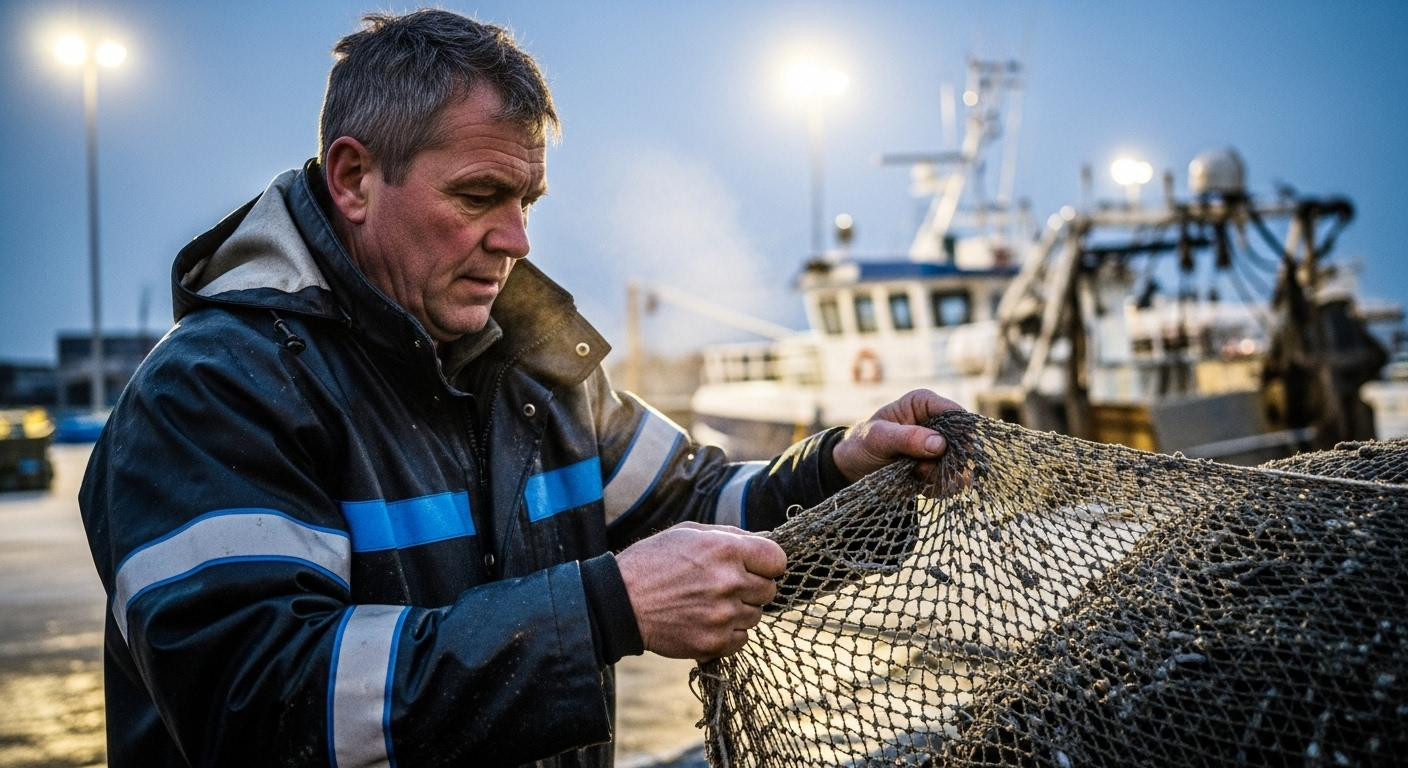Steam rises from coffee cups at 4:30 AM as diesel engines rumble to life along Rockland’s waterfront. The scent of salt and herring bait mingles in November darkness while the Rockland Breakwater Lighthouse blinks across Penobscot Bay. This is Maine’s “Lobster Capital of the World” three hours before tour buses arrive from Portland. Here, 217 licensed lobstermen continue a morning ritual that has defined Knox County for 175 years.
The 4:30 AM harbor awakening tourists never see
Rockland Harbor stirs in pre-dawn darkness while Main Street sleeps. Fluorescent lights flicker on at processing facilities as fishermen check weather apps and tide charts. The harbor master’s office opens at 4:00 AM, coffee brewing for crews preparing their daily routes.
O’Hara Corporation’s docks come alive with the sound of boots on wet planking. Herring trucks arrive from suppliers, unloading fresh bait for the day’s haul. Lobster boats rock gently at their moorings, engines warming in the November cold.
Tourist shops remain shuttered for another five hours. This small coastal community protects its working heritage through daily ritual, not festival weekends. The lighthouse stands sentinel as working boats prepare for another day on Penobscot Bay.
What three generations of lobstermen do before sunrise
Local fishing families arrive at the harbor by 4:00 AM, carrying traditions passed down since the 1920s. Each fisherman maintains 150-200 traps during November’s quieter season, compared to 800 during summer peak. The same wooden-framed, wire-mesh trap designs developed nearly a century ago still fill the docks.
Trap preparation and bait loading at working docks
Fishermen mend traps under dock lights, checking for damage from November storms. Herring bait gets loaded into mesh bags, each trap receiving precise portions calculated by generations of experience. The ritual remains unchanged since Rockland became Knox County’s lobster hub in 1850.
Reading Penobscot Bay’s tides and temperature
Water temperature drops to 40-45°F in November, sending lobsters to deeper waters. Experienced fishermen set traps at 60-90 feet along underwater ledges where warm and cold currents meet. Like other heritage communities, local knowledge trumps modern technology when reading natural patterns.
The harbor route locals navigate daily
Authorized tour operators offer 5:30 AM “Working Waterfront” experiences for $85, contrasting sharply with 10:00 AM tourist cruises. These early departures follow active fishing boats to authentic grounds where lobstering happens, not where it’s performed for cameras.
Following working boats from breakwater to fishing grounds
Maine Lobster Experience and Penobscot Bay Charters provide November access to working hauls. Visitors observe trap hauling, bait replacement, and the careful measuring that returns undersized lobsters to the bay. Three-generation fishing families share sustainable practices developed through 175 years of Bay harvesting.
Where fishermen actually eat breakfast
Harbor View Cafe opens at 4:30 AM, serving the Fishermen’s Special for $8.95. Working industry towns maintain authentic gathering places where locals eat before tourists arrive. Main Street Diner’s back booth remains reserved for fishermen, a tradition honored since 1998.
When tourism meets working heritage at 9 AM
The harbor transforms as boats return with daily catches around 8:45 AM. Tour buses arrive just as fishermen efficiently unload 8,000-12,000 pounds of November lobsters into processing facilities. Working rhythm continues uninterrupted while visitors photograph what locals consider routine Tuesday morning.
Rockland’s 200,000 annual visitors typically miss this authentic transition. Early morning timing reveals the genuine fishing town beneath Maine’s tourist marketing. The lighthouse provides dramatic backdrop, but working boats supply the soul of “Lobster Capital” identity.
Your questions about exploring the fishing heritage of Rockland, Maine answered
What time should I arrive to see authentic fishing activity?
Arrive at Rockland Harbor Park by 5:00 AM for optimal viewing from public areas. Free parking opens at 5:00 AM with legal observation from the harbor park seawall and public landing on Main Street. November through April offers 90% fewer tourists than summer peak, providing unobstructed access to working waterfront activities.
Can visitors join working lobster boats?
Licensed operators offer “working haul” tours from May through October, priced $75-90 for authentic fishing experiences. Harbor Master regulations limit tourist access to protect working operations. Respectful observation means staying behind yellow dock lines, avoiding flash photography during 4:30-6:00 AM safety-focused preparation time, and never touching fishing gear or traps.
How does Rockland compare to Bar Harbor or Portland for authentic fishing culture?
Rockland maintains 217 active lobster licenses versus Bar Harbor’s 89, with 78% working waterfront compared to Bar Harbor’s 35% working/65% tourism ratio. Annual visitors total 200,000 in Rockland versus Bar Harbor’s 3 million, creating authentic working atmosphere. Harbor tours and dining cost 10-15% less than Portland, with genuine lobstermen community preserving daily fishing traditions.
Golden November light touches limestone facades as the 7:30 AM scene unfolds. Traps stacked, boats secured, fishermen heading home for breakfast while tourists sleep in distant hotels. This is Maine’s lobster heritage: not festival weekends but daily 4:30 AM departures that have defined America’s Lobster Capital for generations.
